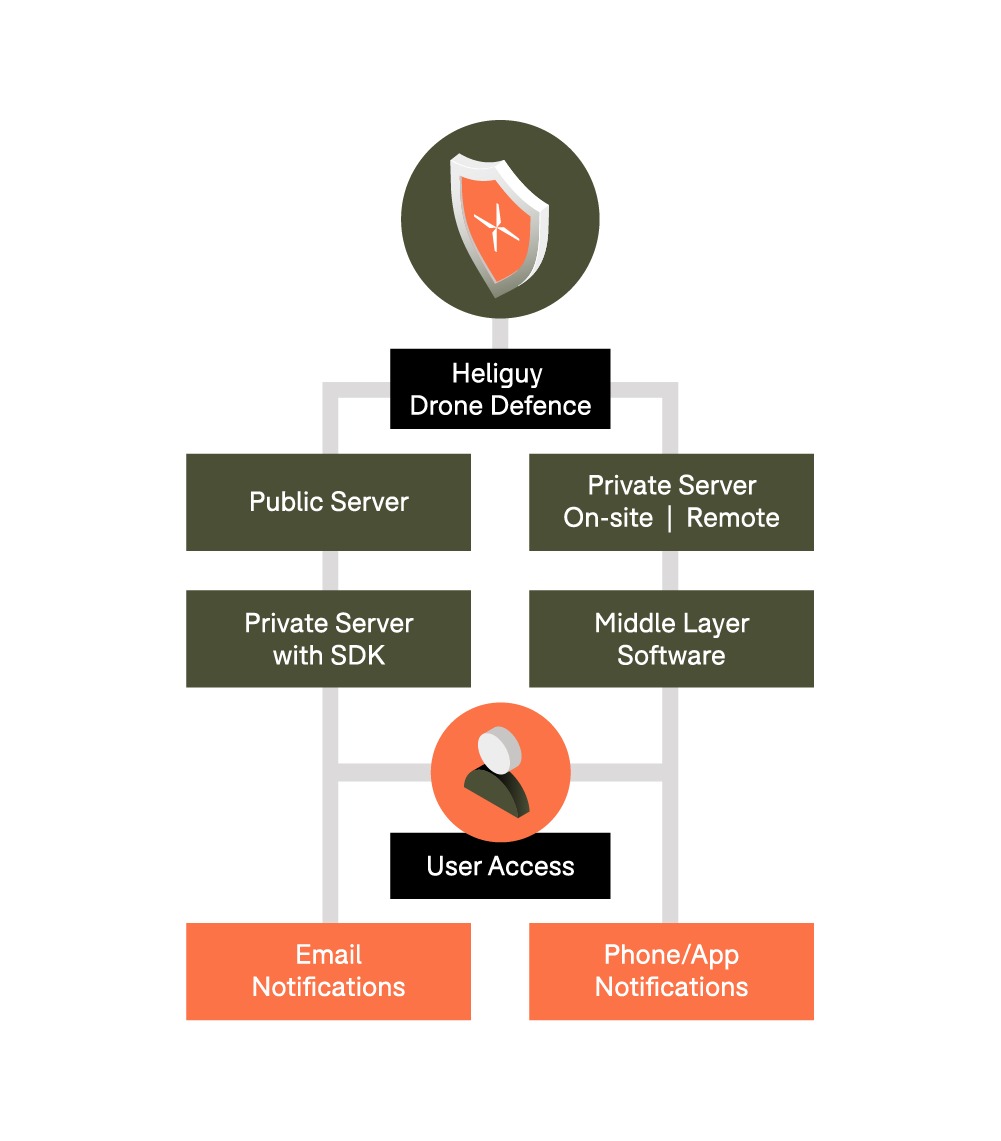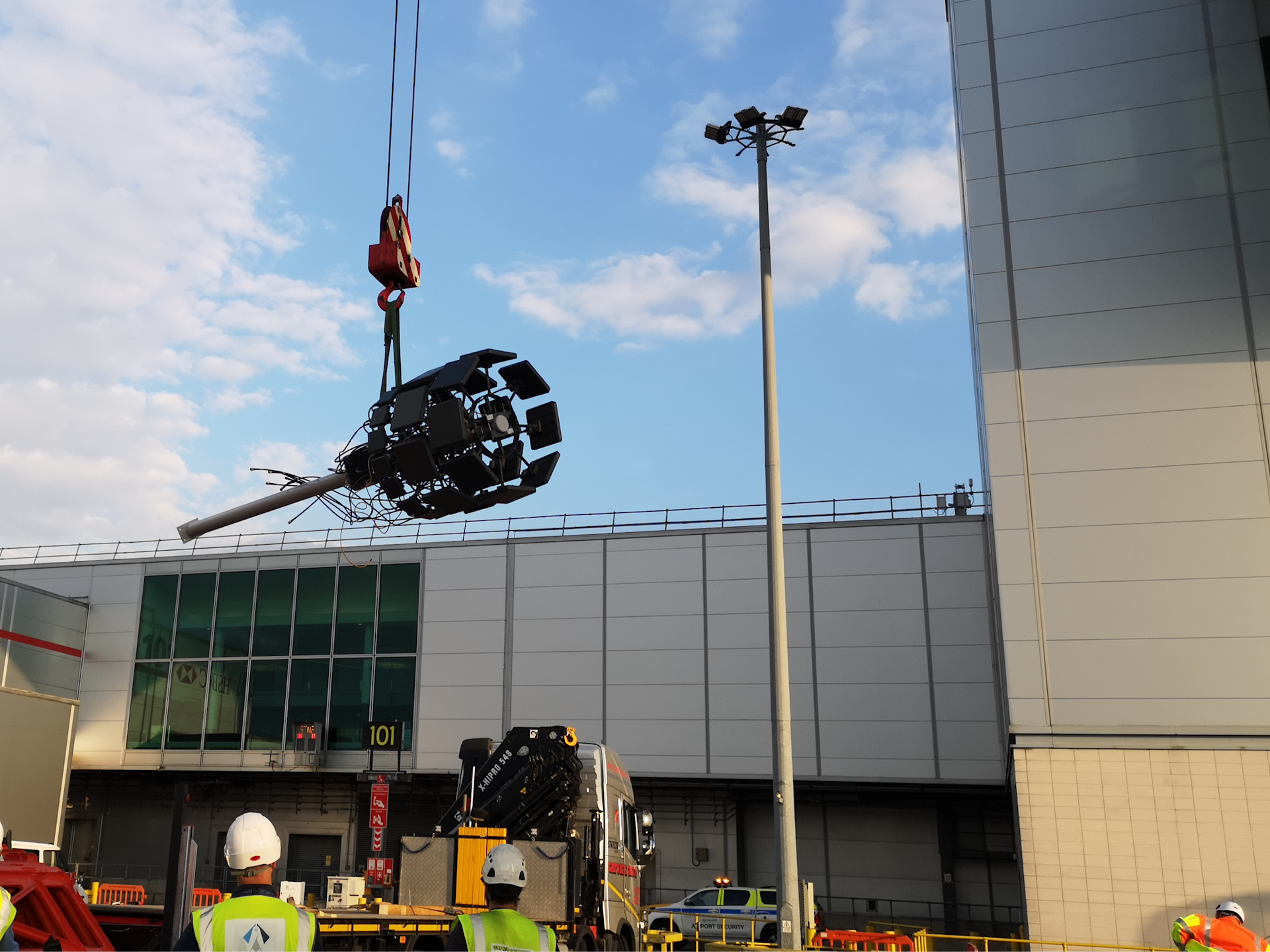Drone Defence
Monitor risk and protect your airspace
Know the Risk and Counter a Drone Strike
Protect and secure your airspace with drone defence.
Determine threat levels in real-time to take the necessary action to counter an attack.

5 Stages Of Drone Defence
Detect: Alert issued when a drone breaches a geofenced area or enters controlled airspace.
Classify: Identify key details about the drone and flight.
Track: Monitor the drone's path and use data to prepare defence strategy.
Respond: Locate drone, seize property, or take alternative action, such as takedown.
Learn: Via analytics - was it the same drone? Is a particular route being constantly targeted? Are there weaknesses in the current strategy?
How is Drone Defence Used?
Airports: Prevents potential collisions with manned aircraft; Minimises disruptions and delays due to unauthorised drone activity; Mitigate risks of surveillance and malicious attacks.

Governments: Defends against espionage and terrorist attacks; Protects critical infrastructure and public events; Maintains control over sensitive areas and information.
Shipping: Safeguards goods from theft and damage; Ensures smooth loading and unloading processes; Enhances monitoring of shipping lanes and ports.

Prisons: Stops the delivery of drugs, weapons, and other illegal items; Improves surveillance capabilities within prison perimeters.
Infrastructure: Safeguards critical infrastructure such as power plants, water treatment facilities, and communication networks; Minimises disruptions to essential services; Enhances monitoring and security measures.
Stadia: Prevents accidents and malicious acts during events; Protects against unauthorised broadcasting and surveillance; Enhances overall security measures for high-profile events.

Don't Cry Wolf: No False Postivies
Data integrity is crucial. Inaccurate information can hinder the creation of effective standard operating procedures and emergency response plans. Reacting to a false alarm can also be expensive and labour intensive. Then there’s the classic Cry Wolf™ scenario: Ignoring warnings due to the past experience of false alarms - only to suffer a drone attack when resources have not been deployed. That’s why drone defence is key. Tools such as heat maps, real-time telemetry information and Remote ID provide a robust and trustworthy solution to reliably raise the alarm and counter a drone threat. A catalogue of historical reports can then be compiled to use analytical learning to plan for and tackle/prevent future threats. A layered solution is most effective for data integrity, utilising different sensors with different capabilities to identify a broader range of drones and cross-reference detection data and risk levels.

Best Drone Defence Technology: Our Solutions
Radio Frequency - DJI AeroScope
Passive radio frequency system, endorsed by the UK’s National Protective Security Authority.
Reliably tracks real-time telemetry data from all DJI drones (around 80% of the market) within its range.
Comes in mobile and stationary formats. The most powerful has a 50km detection range.
Generate flight logs, including statistical reports and heat maps, and access remote monitoring via the G8 and G16 systems.

Radio Frequency - Dedrone RF-360 Sensor
Passive RF sensor, which can be used independently, or as an RF companion to DJI AeroScope.
Detects, classifies and localises drones within a coverage range of 3 miles.
Detects almost all commercial, hobby, and home-made drones, including non-DJI.
Works with DroneTracker Software, which can integrate multiple sensors and is endorsed by the UK’s National Protective Security Authority.

PTZ Cameras
Visually identify a drone and its payload to gain situational awareness.
Monitor large sections of airspace and detect small drones from a great distance.
Collect visual evidence for any potential prosecution.

Drone C-UAS Radar
Measure the direction and position of the drone.
Benefits include its long range, accurate tracking capabilities, ability to handle hundreds of targets simultaneously, and ability to collect data in poor visual conditions.
Particularly effective when used in conjunction with a PTZ/visual camera.

Mobile App and Alert Platform
heliguy™ can integrate an airspace monitoring mobile app into your drone defence solution.
Displays airborne drones on a map - along with the home and RC positions - with a simple and clean user-interface.
Issues alerts when drones are detected in your airspace, via an audible siren or silent-mode phone vibration alerts.
Layered Drone Defence: A Multi-tiered Strategy
A layered solution is the most comprehensive form of drone defence, with multiple technologies working together to plug the gaps and provide a more robust and complete defence strategy.
These systems are integrated via a middle-layer software with full automation and remote monitoring/alerts. Drone defence is scalable, adding extra sensors

Layer One - Single Radio Frequency Drone Detection: Passive systems that collect information such as drone type, speed, and altitude, as well as the location of the drone and pilot. Utilise DJI AeroScope or Dedrone at this stage.
Layer Two - Additional RF Sensors: A dual solution, integrating technology such as DJI AeroScope and Dedrone, to detect a wider range of drones (including non-DJI) and cross-reference alert data.
Layer Three - Additional Technology: Add extra solutions, such as radar and cameras, to expand the scope of your defence strategy.
Layer Four - Mitigation Strategies: Integrate mitigation equipment. The technology that can be used at this stage is unique to each use case and country of operation.
Network Topology
heliguy™ drone defence solutions offer a versatile network topology - effective for a strategy based on DJI AeroScope alone, or utilising AeroScope as part of a layered approach. This topology enables different server options. DJI Aeroscope can feed into a public or private server (on-site or remote) and alert notifications via email and app can be enabled. Alternatively, it can feed into a private server with SDK (Software Development Kit), or a middle-layer software, to enable a multi-tiered approach and enhanced alert methods, such as via dedicated apps.
This is an effective solution for accessing instant and team-wide notifications of a potential drone threat.

heliguy™: Your Drone Defence Partner
heliguy™ is a leading drone defence provider, perfectly placed to provide consultancy, training and hardware to protect your asset. We are DJI's exclusive global AeroScope partner, based on track record, industry experience and understanding of the system. heliguy™ has supplied and installed drone defence solutions to major clients, such as Gatwick Airport, the MET Police, and MOD. We've been at the forefront of industry discussions and demonstrations on drone defence, and have accreditations such as Cyber Security and ISO 9001.
Free Trials and Rentals
Trials of the DJI AeroScope portable station, as well as the G8 stationary solution (conditions apply).
Rental options on the portable and G8 units (conditions apply).

Lifetime Support
24/7 support with a specialist team, consisting of technicians and dedicated account managers.
Manned phone support and monitored email support.
Planned/emergency onsite assistance.
Annual system health check.
Ongoing support.
Replacement parts.
Service Level Agreements on AeroScope G8 and G16 stations.
Planning And Installation
Pre-installation site visit to ensure best location. This includes analysis of the topography/surrounding infrastructure to ensure there will be no third-party interference/disruption.
Preconfigure unit(s) to the chosen site.
Installation of equipment.
On-demand support, should you need it, plus health monitoring of the system done throughout the year.
Yearly site visits to ensure the equipment is operating at peak performance.

API And SDK Access
heliguy™ can grant access to the API (application programming interface) and SDK (software development kit) to enable DJI AeroScope to be integrated with other systems and secure the data on a private onsite or cloud server.
Free Beta access to SDK to export AeroScope data to third-party platforms.
heliguy™ AeroScope servers are operated out of the USA and our technicians can integrate DJI AeroScope with mobile solutions.
